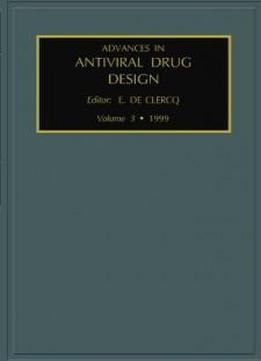
Advances In Antiviral Drug Design, Volume 3
by E. De Clercq /
1999 / English / PDF
3.1 MB Download
Volume 3 of Advances in Antiviral Drug Design is keeping up with
the recent progress made in the field of antiviral drug research
and highlights five specific directions that have opened new
avenues for the treatment of virus infections. First, the use of
lamivudine (3TC) for the treatment of HIV infections, and its more
recent introduction for the treatment of hepatitis B virus (HBV)
infections, has heralded the transition of D- to L-nucleosides in
the antiviral nucleoside drug design, and it is likely that the
future will provide more nucleosides of the L-configuration, such
as (-)FFC (emtricitabine) and L-FMAU, as will be described by
J-C.G. Graciet and R.F. Shinazi. Second, the acyclic purine
nucleoside phosphonates, i.e. PMEA (adefovir and PMPA (tenofovir),
offer great potential as both anti-HIV and anti-HBV agents, and
both compounds have been the subject of advanced clinical trials in
their oral produrg form (adefovir dipivoxil and tenofovir
disoproxyl), as mentioned by M.N. Arimilli, J.P. Dougherty, K.C.
Cundy, and N. Bischofberger. Third, with the advent of nevirapine,
delavirdine, and efavirenz, the NNRTIs have definitely come of age.
Emivirine (MKC-442), a derivative of the original HEPT analog that
was described in 1989 has now proceeded through pivotal clinical
studies, and how this class of compounds evolved is presented in
the account of H. Tanaka and his colleagues. Fourth, at the end of
1999, anticipating on the next winter influenza offensive, we
should have at end two compounds that specifically inhibit
influenza A and B virus infections: zanamivir (by the intranasal
route) and oseltamivir (by the oral route). Both compounds have
proved effective in the prophylaxis and treatment of influenza A
and B virus infections and act through the same mechanism; that is
by blocking the viral neuraminidase (or sialidase), a key enzyme
that allows the virus to spread f
Volume 3 of Advances in Antiviral Drug Design is keeping up with
the recent progress made in the field of antiviral drug research
and highlights five specific directions that have opened new
avenues for the treatment of virus infections. First, the use of
lamivudine (3TC) for the treatment of HIV infections, and its more
recent introduction for the treatment of hepatitis B virus (HBV)
infections, has heralded the transition of D- to L-nucleosides in
the antiviral nucleoside drug design, and it is likely that the
future will provide more nucleosides of the L-configuration, such
as (-)FFC (emtricitabine) and L-FMAU, as will be described by
J-C.G. Graciet and R.F. Shinazi. Second, the acyclic purine
nucleoside phosphonates, i.e. PMEA (adefovir and PMPA (tenofovir),
offer great potential as both anti-HIV and anti-HBV agents, and
both compounds have been the subject of advanced clinical trials in
their oral produrg form (adefovir dipivoxil and tenofovir
disoproxyl), as mentioned by M.N. Arimilli, J.P. Dougherty, K.C.
Cundy, and N. Bischofberger. Third, with the advent of nevirapine,
delavirdine, and efavirenz, the NNRTIs have definitely come of age.
Emivirine (MKC-442), a derivative of the original HEPT analog that
was described in 1989 has now proceeded through pivotal clinical
studies, and how this class of compounds evolved is presented in
the account of H. Tanaka and his colleagues. Fourth, at the end of
1999, anticipating on the next winter influenza offensive, we
should have at end two compounds that specifically inhibit
influenza A and B virus infections: zanamivir (by the intranasal
route) and oseltamivir (by the oral route). Both compounds have
proved effective in the prophylaxis and treatment of influenza A
and B virus infections and act through the same mechanism; that is
by blocking the viral neuraminidase (or sialidase), a key enzyme
that allows the virus to spread f











